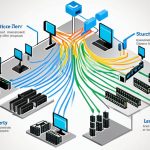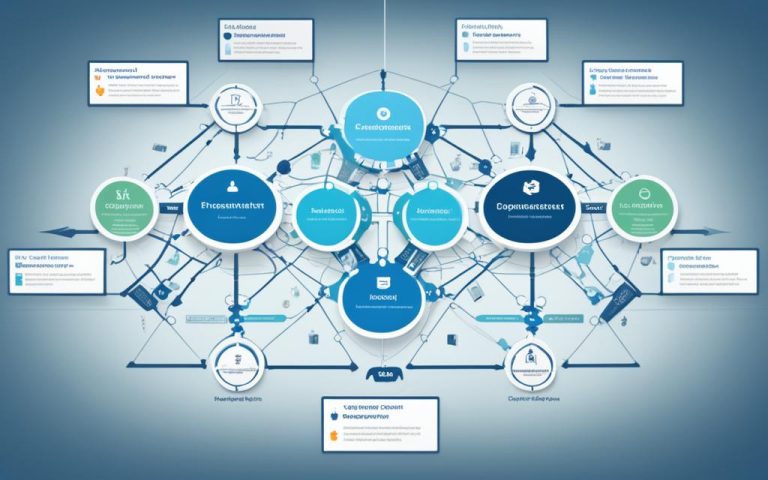In today’s fast-changing digital world, network automation is key for companies wanting to make their networks easier to manage. It uses automation tools to improve how networks are set up, managed, and fixed. This makes things run smoother and faster.
Python is now the top choice for network automation because it’s easy to read, has lots of libraries, and many companies use it1. A Python script saved a lot of time by automating the setup of over a thousand switches’ VLANs1. Other languages like Perl and Ruby are also used for specific automation tasks1.
Tools like Puppet, Chef, and Ansible have changed how we automate networks by making it easier to keep track of changes1. It’s important for apps to grow and adapt to keep up with network needs1. Making network automation apps faster to develop helps keep networks safe and reliable1.
Working together, IT pros, network engineers, and software developers create apps that are both smart and practical1. Testing automation is key to making sure networks work well and fix any issues1. Automating help desks can cut down on how long it takes to solve problems, making things better for everyone1. Making it easier to develop apps for different network types can make things simpler and more efficient1.
Key Takeaways:
- Python has become the go-to language for network automation1.
- Testing automation is vital for network automation1.
- Help desk automation can greatly reduce how long it takes to solve problems1.
- Streamlining app development for different networks can make things simpler1.
- Working together is key for successful network automation1.
How Network Automation Works to Streamline and Simplify Network Operations
Network automation is key for making network operations smoother and more efficient. It helps businesses use data2 to speed up tasks like setting up and managing networks. This leads to less downtime, better reliability, and cost savings.
Automation cuts down the time it takes to set up and configure network devices. IT teams can now do this in minutes, not hours or days2. It also makes sure all devices are set up the same way, reducing mistakes that can cause problems2. This makes the network more reliable and available.
Automating network setup makes it easier to grow the network without slowing down. This lets businesses adapt to new needs and tech easily2. Automation also keeps configurations the same, lowering the risk of mistakes that could lead to security issues2.
Automation lets you set up configurations on many devices at once. This saves a lot of time, letting IT teams work on important tasks2. It also helps keep the network secure by checking for and fixing any settings that don’t follow rules2.
Automation in monitoring and fixing network problems helps find and fix issues fast. It keeps an eye on the network and can spot problems early, reducing downtime2. Automation tools can quickly find the cause of issues, making repairs faster2.
Automation keeps track of how the network is doing and uses data to make it better. It finds slow spots and suggests ways to improve, making the network run smoother2.
Network automation makes network operations simpler and more efficient. By using automation tools and data2, businesses can cut downtime, improve reliability, and save money. This helps them succeed in a world full of technology.
Common Use Cases for Network Automation
Network automation is key for companies wanting to make their network work better and more efficiently. It automates many tasks, freeing up resources for more important work. Let’s look at some ways network automation is used:
Automated Network Provisioning
Provisioning means setting up and managing network devices. Automation makes this process easier, cutting down on mistakes and saving time. It makes adding new devices quick and easy, making the network grow without a hitch.
This automation also makes sure all devices are set up the same way, making the network more reliable and fast3.
Configuration Management Automation
Keeping a network stable and safe is crucial. Automation helps with this by taking care of tasks like backing up settings, updating software, and following rules. It lowers the risk of mistakes and keeps the network running smoothly3.
Network Monitoring and Troubleshooting Automation
Watching over the network is key to spotting and fixing problems before they get worse. Automation helps find and fix issues fast, keeping the network up and running. It sends alerts in real-time, watches how well the network is doing, and helps fix problems quickly4.
Automation uses data to spot trends, find oddities, and predict problems, making the network work better and less often5.
Network automation brings big benefits in many areas. It makes setting up networks easier, keeps settings right, and helps with watching and fixing the network. This helps companies run their networks better and succeed in their goals.
Network Automation Tools and Services
Network automation has changed how networks are managed, making them more efficient and reliable. To get better automation, companies use many network automation tools and services.
Ansible: Simplifying Network Configuration and Management
Ansible is a top tool for network automation. It’s an open-source platform that makes setting up and managing networks easier5. Ansible uses a simple language and has lots of automation modules. This lets network admins automate tasks well.
Using Ansible for network tasks boosts efficiency and cuts down on mistakes. It lets admins focus on big projects, which leads to more innovation and new jobs5. Its easy use and wide range of network functions make it a top pick for many companies.
Cisco DNA Center: Centralized Network Management and Automation
Cisco DNA Center is another key tool for network automation. It offers a full platform for managing and automating networks. It combines intent-based networking, automation, and assurance for better network operations5.
Intent-Based Networking (IBN) is a big part of network automation. It turns business goals into automatic network settings, making things more efficient and cutting down on mistakes5. With Cisco DNA Center, admins can set their network policies. The tool then automates the setup and checking of these policies, saving time and effort5.
Advanced Network Automation Techniques and Services
While Ansible and Cisco DNA Center are big names, other tools also play a role in network automation67. Self-organizing networks (SON) automate device settings and make networks work better to meet service level agreement (SLA) standards6. Automation tools speed up network tasks, making them more efficient and less prone to problems6. In private 5G networks, automation ensures reliable connections and meets strict performance needs for apps6. Tools like the Celona platform use advanced automation to make private mobile networks easier to set up6.
SDN and NFV are key for dynamic network service provisioning, virtualization, and automation5. These technologies, with automation, help admins manage many networks efficiently7.
References
- GeeksforGeeks – What is Network Automation
- Celona – Network Automation in Celona’s
- Cisco Blogs – Open NX-OS Journey: Part 4 – Automating with Guest Shell, Part
The Benefits of Network Automation
Network automation brings big wins for businesses. It boosts efficiency, productivity, and cuts costs. By using automation tools, companies can make their networks run smoother, reduce mistakes, and use resources better. Here are the main perks of network automation:
1. Increased Efficiency: Automation makes network tasks quicker and more reliable. This means better service for big networks8. It frees up network experts to focus on big projects and help with DevOps8. This leads to better efficiency and speed.
2. Enhanced Productivity: Automation cuts down on manual tasks for network admins. They can then use their skills for more important work, driving innovation and growth8. It also makes adding new network parts across many sites easier, making network growth simpler8.
3. Cost Savings: Automation saves money in several ways. It cuts down on mistakes and prevents network failures, saving money from downtime8. Automation also makes sure issues get fixed quickly, making other automation tasks work better8. Plus, it helps save energy and money by turning off unused resources when not needed8.
Using automation in private 5G networks means reliable connections and meeting app SLA needs8. For example, the Celona platform offers automation for private mobile networks, making setting up and growing private networks easier8.
Automation also tackles network management challenges. The 2023 Uptime survey found many outages come from human mistakes in setting up networks9. Automation in setting up networks cuts down on errors and makes networks more stable.
| Benefits | Link 1 | Link 2 | Link 3 |
|---|---|---|---|
| Increased Efficiency | ✓ | ||
| Enhanced Productivity | ✓ | ||
| Cost Savings | ✓ | ||
| Reliable Connections | ✓ | ||
| Compliance with SLA | ✓ | ||
| Auto-provisioning | ✓ | ||
| Optimization of Airtime | ✓ |
Automated Network Provisioning: Efficiencies and Benefits
Automated network provisioning makes network operations simpler and more efficient. It automates tasks like setting up and managing network resources. This cuts down on manual work and lowers the chance of mistakes.
This method saves businesses time and money. It makes processes more flexible and quick, helping companies reach their goals faster. Automated tasks run up to 100% faster than manual ones, boosting efficiency10.
Automated networks also reduce errors by having less human input. This lowers the risk of mistakes and saves money. It makes networks more reliable and secure, improving performance and reducing vulnerabilities119.
Network automation focuses on efficiency. Tools for automated network provisioning are key in this area. They help save time and ensure projects meet deadlines, keeping businesses competitive11.
Using Infrastructure as Code (IaC) with these tools makes networks more efficient. It keeps network settings consistent and helps teams work better together11. This makes it easier to add or remove devices as needed, making the network more scalable11.
These tools also boost security by following best practices during setup119. This lowers the risk of network outages caused by human mistakes, which is about 45% of the time9.
Tools like Cisco Prime Infrastructure and SolarWinds Network Configuration Manager (NCM) are popular. Cisco Prime Infrastructure gives full control over Cisco devices, improving network setup and troubleshooting11. SolarWinds NCM helps keep networks consistent and efficient with its provisioning and management tools11.
In summary, automated network provisioning brings big benefits to businesses. It makes setting up and managing network devices easier and faster. By cutting down on manual work and reducing errors, it saves time, money, and boosts network performance.
The Benefits of Configuration Management Automation
Configuration management automation is key to keeping network settings consistent and cutting down on errors. It makes sure that network settings are the same everywhere, which keeps the network stable and secure12.
By automating tasks, these tools cut down on mistakes and speed up the process. This is crucial for meeting deadlines and staying ahead in the market12.
One big plus is that it keeps network settings the same everywhere. This stops settings from changing on their own and keeps the network safe and stable12.
It also makes the network more secure by following the best security practices during setup. This lowers the chances of cyber threats and makes the network stronger12.
Another advantage is how easy it makes growing the network. IT teams can add or remove devices without a lot of work. This lets companies quickly adjust to new needs12.
Modern tools work well with Infrastructure as Code (IaC) frameworks. This means they help keep settings consistent, track versions, and help teams work together better12.
These tools also have network orchestration features. This automation makes different network tasks work together smoothly12.
Also, they can work with Software-Defined Networking (SDN) controllers. This makes the network more flexible and quick to change, helping businesses adapt to new needs fast12.
There are many configuration management tools out there, each with its own benefits. Bitbucket Pipelines, for example, automates workflows right in the Bitbucket repository. It also works well with Jira Software and Jira Service Management to help teams work better together13.
Other top tools like Kubernetes, SaltStack, Git, Puppet, Ansible, and Chef are great for managing big infrastructures and automating tasks. They make software more stable, easy to reproduce, and help with troubleshooting. This makes managing and deploying configurations easier13.
The global DevOps market is expected to hit USD 14.97 billion by 2026, growing at a 19.1% annual rate14. Google’s study shows how important it is to quickly develop and release new software, with most businesses agreeing14. Also, 77% of companies are using or planning to use DevOps for software deployment, showing its wide use across industries14.
The Benefits of Network Monitoring and Troubleshooting Automation
Network monitoring and troubleshooting automation are key for today’s IT setups. They help businesses quickly find and fix network problems15.
Automating network checks lets businesses spot issues early. They can see where things might slow down and predict how the network will perform. This means they can act fast to keep the network running smoothly15.
Automated systems can spot and fix problems right away, often before users notice them. This quick action means less downtime and keeps business running without a hitch15.
Automated tools give IT teams deep insights into network issues. This helps them fix problems faster and more efficiently, making the network work better15.
By always watching the network, businesses can stop problems before they start. This proactive approach keeps the network running well and users happy15.
Automated tools also let IT teams see what’s happening on the network in real-time. They can check on traffic, how apps are doing, and security. This helps them manage the network better and keep users happy16.
Automated troubleshooting speeds up fixing problems and cuts down on manual work. This means faster solutions, less time wasted, and more work done efficiently16.
Network monitoring and automation are also key for keeping networks safe. They watch for security threats and act fast to stop them. This reduces the risk of cyber attacks16.
In summary, network monitoring and automation help keep networks stable, fast, and reliable. They let businesses find and fix problems early, which means less downtime and happier customers1516.
Benefits of Network Monitoring and Troubleshooting Automation
| Benefits | Statistical Data Reference |
|---|---|
| Proactive issue detection | 15 |
| Faster troubleshooting | 15 |
| Real-time network monitoring | 15 |
| Advanced data insights | 15 |
| Improved network security | 16 |
| Enhanced network reliability and stability | 15 |
| Optimized network performance | 16 |
| Reduced downtime | 1516 |
| Increased operational efficiency | 16 |
| Enhanced customer satisfaction | 16 |
Choosing the right tools and technologies for network monitoring and automation is important. It’s key to pick solutions that fit the company’s needs and tackle the challenges of automation151617.
Overcoming hurdles like changing work habits, old systems, and making different parts work together is crucial. It’s the only way to fully use the benefits of network monitoring and automation1517.
By investing in top-notch automation tools, companies can make their network monitoring and troubleshooting better. This leads to more efficient work, less downtime, and better network performance1516.
The Future of Network Automation
The future of network automation is set to change a lot thanks to AI, machine learning, and data science. These new technologies will help us understand network operations better. They will also make upgrades based on what services need.
Using AI in network automation lets companies use smart algorithms to make networks work better. These algorithms can predict problems and fix them before they happen. Machine learning helps these systems get better over time.
Data science and network automation will work together to make things more efficient and innovative. With data insights, companies can make smart choices. They can spot patterns and set up networks to meet new demands.
AI, machine learning, and data science make complex decisions easier in network automation. They use advanced algorithms and predictive analytics. This means networks can run smoother, with fewer mistakes, and more efficiently.
Networks powered by these technologies will manage better, grow to handle more complexity, and keep settings the same for better security and following rules.
AI and data science in network automation also mean quicker fixes and less downtime. Automated tools can find and fix network problems fast. This keeps networks running smoothly.
Also, the future will see more focus on areas like data center automation, cloud networking, security, branch office networking, and IoT connectivity and security.
Key Trends Shaping the Future of Network Automation
Several trends will shape the future of network automation:
- Increased Integration of AI: AI will be key in network automation, making smart decisions and predicting problems.
- Advanced Machine Learning Algorithms: Machine learning will keep learning and adapting to make networks better and solve problems faster.
- Data-driven Network Optimization: Data science will help companies use insights to improve networks and adapt to new needs.
- Expansion of Automation Use Cases: Automation will be used in more areas, like data centers, cloud networks, and IoT.
- Enhanced Security Automation: Automation will help fight security threats and follow rules faster through automated security policies.
- Improved Operational Scalability: Automation will make networks more scalable, helping companies handle complex networks better.
- Empowering Network Administrators: Automation will take over routine tasks, letting network admins focus on strategy and new tech.
The future of network automation is exciting, combining AI, machine learning, and data science to make networks better, more efficient, and open new chances for businesses. Using these technologies will help companies stay ahead in a world that’s more connected every day.
Conclusion
Network automation is changing the game for businesses. It uses automation tools to make network operations smoother. This leads to more efficiency, better productivity, and saving money.
According to a 2023 survey, about 45% of network failures come from human mistakes9. Python is now the top choice for network automation because it’s easy to use and has lots of support9. Open-source tools are also popular for being open, quick, and saving money9.
For network automation to work well, start small and focus on security. Use version control and standardize your setup. Automate routine tasks and manage big projects to cut down on mistakes and speed up changes9.
Tools like Ansible® Automation Platform are key in network automation. It works with over 200 vendors without needing agents, making it a top choice for managing networks20. But, tools like Nornir and Terraform are also making waves, offering new options20.
Platforms like BackBox help automate big tasks in networks and security, working with over 180 vendors20. It’s easy to set up and can find networks automatically, helping businesses get better at automation20.
In summary, network automation brings big benefits like more efficiency, better productivity, and saving money. By following best practices and using strong tools, companies can manage their networks better. This helps them keep up with new apps and stay ahead in the digital world.
FAQ
What is network automation?
Network automation uses software and tools to manage network devices and services automatically.
How does network automation streamline and simplify network operations?
It cuts down on manual work, lowers mistakes, and speeds up tasks. This makes networks more reliable and available.
What are the common use cases for network automation?
Common uses include setting up networks automatically, managing configurations, and fixing network issues without human help.
What are some network automation tools and services?
Ansible is a top tool. It’s open-source and makes managing networks easier.
What are the benefits of network automation?
It boosts efficiency, productivity, and cuts costs by reducing mistakes and preventing network failures.
How does automated network provisioning benefit businesses?
It makes setting up and configuring network devices easier, leading to smoother network operations.
What are the benefits of configuration management automation?
It keeps network devices consistent and accurate, cutting down on errors and boosting performance.
How does network monitoring and troubleshooting automation benefit businesses?
It finds problems early and fixes them quickly, reducing downtime and improving network reliability and speed.
What is the future of network automation?
The future combines AI, machine learning, and data science for better network analysis and service upgrades.
What are the best practices for implementing network automation?
Start small, use version control, and keep security in mind for the best results.
Source Links
- https://creatifyi.com/network-automation-tools/ – Network Automation Tools: Which Component Streamlines The development of network automation applications
- https://www.versitron.com/blogs/post/benefits-of-network-automation-to-streamline-and-simplify-network-operations – Network Automation Streamline and Simplifies the Network Operations | Versitron
- https://pliant.io/top-6-network-automations/ – The Top 6 Network Automation Use Cases that Drive Business Value – Pliant – The Orchestration Platform
- https://configr.medium.com/network-automation-with-python-and-ansible-streamlining-configuration-provisioning-and-adae19e2fad2 – Network Automation with Python and Ansible: Streamlining Configuration, Provisioning, and…
- https://www.geeksforgeeks.org/what-is-network-automation/ – What is Network Automation? – GeeksforGeeks
- https://www.celona.io/network-architecture/network-automation – What Is Network Automation? A Simple Explanation & Overview
- https://blogs.cisco.com/developer/open-nx-os-journey-4 – Network Automation and Programmability with Cisco Open NX-OS – Part 4
- https://celona.io/network-architecture/network-automation – What Is Network Automation? A Simple Explanation & Overview
- https://hardwarenation.com/resources/blog/the-power-of-network-automation-key-insights/ – The Power of Network Automation: Key Insights
- https://www.cprime.com/resources/blog/what-are-the-benefits-of-network-automation/ – What Are the Benefits of Network Automation?
- https://ucslogistics.com/post/network-provisioning-tools-and-automation – Efficient Network Provisioning: The Power of Automation | UCS Logistics
- https://www.ucslogistics.com/post/network-provisioning-tools-and-automation – Efficient Network Provisioning: The Power of Automation | UCS Logistics
- https://www.atlassian.com/microservices/microservices-architecture/configuration-management-tools – 9 Best Configuration Management Tools [2024] | Atlassian
- https://www.veritis.com/blog/chef-vs-puppet-vs-ansible-comparison-of-devops-management-tools/ – DevOps Tools Compared: Chef vs. Puppet vs. Ansible
- https://www.kentik.com/kentipedia/network-automation/ – Network Automation: Enhancing Performance and Reducing Complexity
- https://moldstud.com/articles/p-exploring-the-benefits-of-network-automation-for-university-system-administration – Exploring the Benefits of Network Automation for University System Administration
- https://www.javatpoint.com/network-automation – Network Automation: Benefits and Challenges of Automating Network Management and Configuration – javatpoint
- https://sageuniversity.edu.in/blogs/future-of-networking-a-dive-into-network-automation – The Future of Networking: A Dive into Network Automation
- https://blogs.cisco.com/datacenter/streamline-your-infrastructure-automation-workflows-by-going-beyond-infrastructure-as-code – Streamline your Infrastructure Automation Workflows by going beyond Infrastructure-as-Code?
- https://www.rogerperkin.co.uk/network-automation/tools/ – Network Automation Tools List for 2024 | Roger Perkin | Best Network Automation Software 2024 | Best Tools for Network Automation | Network Automation Tools



















